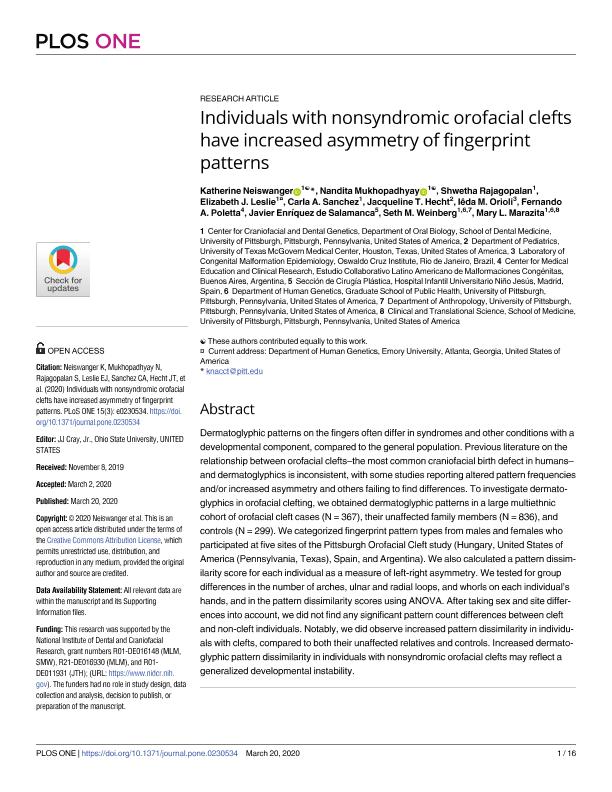Artículo
Individuals with nonsyndromic orofacial clefts have increased asymmetry of fingerprint patterns
Neiswanger, Katherine; Mukhopadhyay, Nandita; Rajagopalan, Shwetha; Leslie, Elizabeth J.; Sanchez, Carla A.; Hecht, Jacqueline T.; Orioli, Ieda Maria; Poletta, Fernando Adrián ; de Salamanca, Javier Enríquez; Weinberg, Seth M.; Marazita, Mary L.
; de Salamanca, Javier Enríquez; Weinberg, Seth M.; Marazita, Mary L.
 ; de Salamanca, Javier Enríquez; Weinberg, Seth M.; Marazita, Mary L.
; de Salamanca, Javier Enríquez; Weinberg, Seth M.; Marazita, Mary L.
Fecha de publicación:
03/2020
Editorial:
Public Library of Science
Revista:
Plos One
ISSN:
1932-6203
Idioma:
Inglés
Tipo de recurso:
Artículo publicado
Clasificación temática:
Resumen
Dermatoglyphic patterns on the fingers often differ in syndromes and other conditions with a developmental component, compared to the general population. Previous literature on the relationship between orofacial clefts-the most common craniofacial birth defect in humans-and dermatoglyphics is inconsistent, with some studies reporting altered pattern frequencies and/or increased asymmetry and others failing to find differences. To investigate dermatoglyphics in orofacial clefting, we obtained dermatoglyphic patterns in a large multiethnic cohort of orofacial cleft cases (N = 367), their unaffected family members (N = 836), and controls (N = 299). We categorized fingerprint pattern types from males and females who participated at five sites of the Pittsburgh Orofacial Cleft study (Hungary, United States of America (Pennsylvania, Texas), Spain, and Argentina). We also calculated a pattern dissimilarity score for each individual as a measure of left-right asymmetry. We tested for group differences in the number of arches, ulnar and radial loops, and whorls on each individual's hands, and in the pattern dissimilarity scores using ANOVA. After taking sex and site differences into account, we did not find any significant pattern count differences between cleft and non-cleft individuals. Notably, we did observe increased pattern dissimilarity in individuals with clefts, compared to both their unaffected relatives and controls. Increased dermatoglyphic pattern dissimilarity in individuals with nonsyndromic orofacial clefts may reflect a generalized developmental instability.
Palabras clave:
Oral cleft
,
Cleft lip
,
Cleft palate
,
Dermatogliphics
Archivos asociados
Licencia
Identificadores
Colecciones
Articulos(CEMIC-CONICET)
Articulos de CENTRO DE EDUCACION MEDICA E INVESTIGACIONES CLINICAS "NORBERTO QUIRNO"
Articulos de CENTRO DE EDUCACION MEDICA E INVESTIGACIONES CLINICAS "NORBERTO QUIRNO"
Citación
Neiswanger, Katherine; Mukhopadhyay, Nandita; Rajagopalan, Shwetha; Leslie, Elizabeth J.; Sanchez, Carla A.; et al.; Individuals with nonsyndromic orofacial clefts have increased asymmetry of fingerprint patterns; Public Library of Science; Plos One; 15; 3; 3-2020; 1-16
Compartir
Altmétricas



